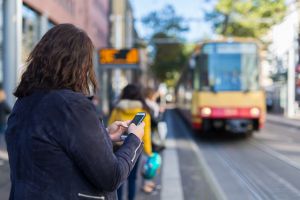Relying on public transport as a newcomer or occasional user can be rather stressful. For some years now, apps have been helping users to find the right bus or train. What many users do not know: The digital helpers do not always tell us the best route when considering e.g. the number of changes of buses or trains or even other transport means, such as cars or bicycles. Researchers of Karlsruhe Institute of Technology (KIT) work on a remedy.

Apps help travelers in planning public transport routes, but often fail to display the best route. (Photo: Robert Fuge, KIT)
“Today’s route planners, for instance, do not consider walks,“ says Dorothea Wagner, Head of KIT’s Institute of Theoretical Informatics. On balance, it might be quicker to walk ten minutes to the bus stop than to use the underground around the corner, the professor of algorithmics points out. The situation is similar when additional means of transportation, such as taxis or bicycles, have to be taken into account, or park and ride scenarios, when travelers park their car near stops of public transport and then use the bus, train, or tram.
Wagner solves the problem with highly efficient algorithms. “Algorithmically speaking, it is not very demanding to identify the quickest route,” says the expert. Such programs have been available for twenty years now. The problem is the mass of data describing more complex transportation scenarios. “We have to get quicker.” This is to be achieved by combining smart pre-calculations with quick algorithms to determine the best transport connections. First results mark a breakthrough in this area and will be presented at the international conference ALGO 2019 in Munich in September.
The results will also help planners of public transport optimize their schedules and operational planning. Changing needs of customers will influence the routes and times for which more or less vehicles have to be deployed.
The German Research Foundation (DFG) will continue funding of the research group FOR 2083 on “Integrated Planning for Public Transportation” for another three years until 2021. Apart from the KIT, Stuttgart University, the University of Halle-Wittenberg, and the Fraunhofer Institute for Industrial Mathematics, Kaiserslautern, are involved in the project. The total amount of funding for the three years is about EUR 1.5 million. Funding will be distributed to the four research locations.
More about the KIT Information · Systems · Technologies Center: http://www.kcist.kit.edu ![]()